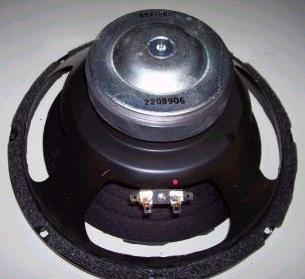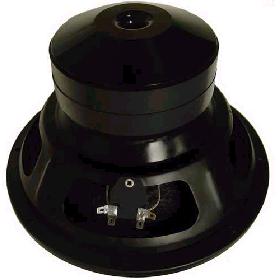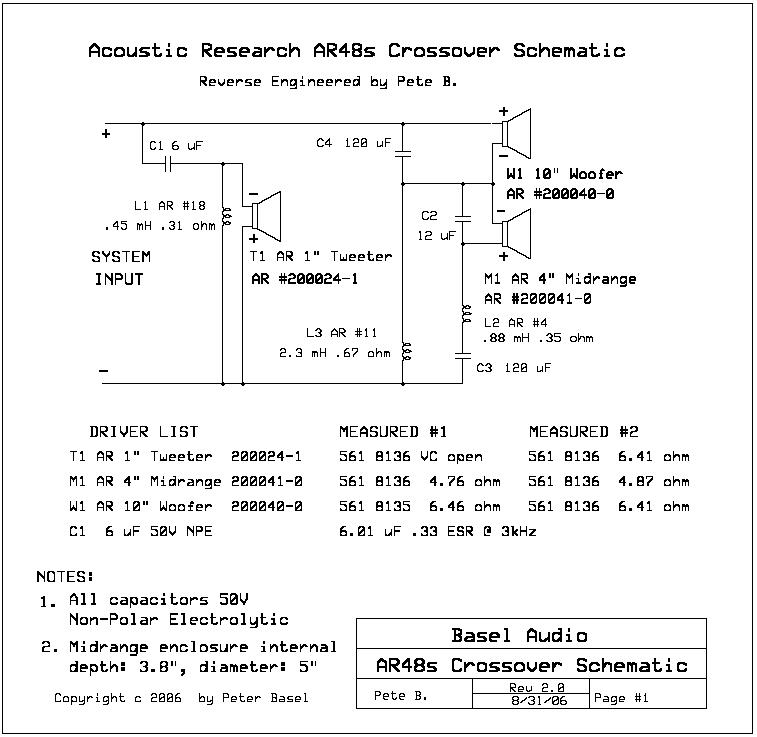The Vintage Acoustic Research
AR48s (1981) Speaker System
By Pete B. August 2006
Introduction
===================================================
I was recently given a pair of AR48s speakers from a friend
who
was moving and needed to get them out as soon as possible. I
do
not have a strong interest in these speakers and was not too familiar
with them. I found on closer examination that they are a
3-way
system with a 10" acoustic suspension woofer, 4" paper cone midrange,
and a 1" fabric dome tweeter. I see this as the evolution of
the
AR-2ax, and AR-5 designs which are also 10" 3-way systems.
The 1"
tweeter
reaches lower into the midrange permitting a lower and better crossover
point of 2500 Hz.
The
4" cone mid offers much more bandwidth than the 1.5" dome of the AR-5,
and
the 10" woofer offers similar performance to the 10" drivers previously
used.These speakers have some challenging problems. One of the tweeters has an open voice coil, and both midranges have disintegrated rubber surrounds. The woofers have been refoamed however one has a voice coil scrape problem.
These are vinyl cabinet speakers with inexpensive, plastic input posts, and no level controls. Before opening them I thought that they were nothing like the older AR speakers. However, internally I did find a complex crossover network with all air core inductors, and NPE capacitors. There are no resistors which seems to follow from the fact that many people listened to most AR's with the mid and tweeter controlls all the way up. The majority of well balanced speakers today use roughly 3 to 6 dB of padding on the tweeter. If AR deliberately made the tweeter less efficient then it would run hotter and likely burn out. The tweeter has a 10 oz magnet and looks typical of most 1" fabric domes, I think it was just voiced to be bright. Mids also usually have some padding, these also have good sized magnets but the efficiency also depends on the amount of overhang and cone mass.
The
10" woofer reminds me of a cheap
stamped frame CTS driver that might
go for $15 to $20 bucks in a catalog. Looks like a 16 oz
magnet,
good sized spider but not huge, and a slightly raised back plate.
The woofer parameters are logically chosen to provide decent
acoustic suspension performance. The
Large Advent 10" woofer on a 12" frame which has a huge spider, and
thicker
magnet for more mcchanical Xmax is far superior. Here's a
picture
with the AR 10" woofer on the left and the Advent 10/12" on the right.
The newer Advent Legacy 10" woofer is shown below, note the
much
higher bump in the backplate.

AR 10" Woofer (left), Advent 10/12" Woofer (right)


Figure 1. Advent 10" Legacy above (left), Modern Low Cost 10" High Excursion Subwoofer (right)
I wasn't sure what to do with these at first, then thought I might just use the enclosures to show what can be done with modern drivers as compared to the older designs. I'll probably restore them to also have working examples of the AR48s. It will be some time before I get around to finishing these as they're not a high priority at this time.
Crossover Design
===================================================
The crossover uses a combined series parallel topology as a
cost savings in order to eliminate one inductor. The tweeter
section
is a standard 2nd order parallel network. The woofer network
can be
seen
below as a standard 2nd order network comprised of L3 and C4, however
the midrange and its network shunt across L3. This makes L3
less
effective since the midrange system will shunt some energy to the
woofer making it's lowpass crossover first order over part of the
transition band. L3 also partly acts to shunt low frequency
energy
away from the midrange system, in place of the inductor that normally
shunts the first order high pass network comprised of C3 feeding the
midrange. L2 and C2 form a second order low pass network to
the
midrange. I would have preferred a full parallel crossover
network which provides better slopes and more flexibility at the cost
of one inductor. Also note that the woofer is in phase with
the
input, and the midrange and tweeter are both out of phase with the
input. The midrange is electrically out of phase with the
woofer,
and this was perhaps required for this particular series connected
network. The midrange and tweeter are in phase relative to
each
other and the 2nd order electrical networks combined with the driver
acoustical responses likely provide an approximate 4th order overall
response which are normally wired in phase. This is just an
overview of what is going on, measurements would be required, after
refoaming the midranges, to determine the electro-acoustical responses
of the drivers and system.Crossover
Schematic

Figure 2. AR 48s Crossover Schematic
Bill of Materials For One System
| U NUMBER | DESCRIPTION | MANUFACTURER NUMBER |
| C1 | 6 uF | |
| C2 | 12 uF | |
| C3 | 120 uF | |
| C4 | 120 uF | |
| L1 | .45 mH .31 ohm | AR #18 |
| L2 | .88 mH .35 ohm | AR #4 |
| L3 | 2.3 mH .67 ohm | AR #11 |
| M1 | AR 4" Midrange | AR #200041-0 |
| T1 | AR 1" Tweeter | AR #200024-1 |
| W1 | AR 10" Woofer | AR #200040-0 |
The AR48s Drivers
===================================================
AR48s Tweeters
The failed tweeter with the open voice
coil was already disassembled and it looks like a common one inch
fabric dome tweeter. There is a white felt pad covering the
center pole, and the center pole piece is part way drilled to provide a
small
chamber. Interestingly, there are three of what I call "v
cuts"
or notches in the top plate which AR also used in most of the .75"
tweeters, as in the AR-11and AR-3a for example. I've never
seen
notches like these in any other tweeter. This tweeter is very
similar to the old reliable Peerless KO-10-DT.I measured the VC diameter with a caliper and then compared it to a 1" dome replacement unit for a Vifa tweeter and found them to be identical. I found that this replacement dome assemble fit right into the AR tweeter. The replacement dome was an aluminum type but there was a fabric type of identical dimensions that could be ordered. The dome assembly should be shimmed to center the voice coil in the magnetic gap. Longer face plate mounting screws were needed.
The measured parameters are given below, the pole chamber should be filled in order to raise Fs as close as possible to the original AR tweeter. Damping behind the dome can be adjusted to match Qts. Some series resistance should be added to match the impedance as close as possible to the original, and padding should be used to match the sensitivities of the two tweeters. Here's a picture of the two tweeters, note that the stainless steel face plate screws have not yet been cut to the correct length:

Figure 3. Stock original AR Tweeter (left), Failed Unit Repaired With Vifa Dome (right)
AR48s Driver Measurements